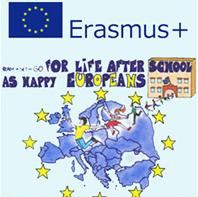THE PROJECT | About the project
Hits: 739

THE PROJECT | About the project

THE PROJECT | About the project
How can young people achieve happiness?
- This topic is already a regular subject in some EU countries. -
How can young people achieve happiness? This topic is already a regular subject in some EU countries. Young people want to be happy but very often they lack in finding appropriate ways or initiatives how to get there. The EU ‘strategic framework’ “Education and training 2020” has got four strategic objectives and they are manifested in the initiatives of this project. Mobility is an intrinsic value of every project in the KA2 frame, our activities aim at improving the quality of education and training as well as “social cohesion and active citizenship” and finally a lot of innovation and creativity is needed to reach our objectives. When “The Action for Happiness” asserts that “Doing good is one of the best ways to feel good, people who care more about others are happier than those who care less about others “[http://www.actionforhappiness.org/why-happiness], it meets one of the objectives of our project, related to the field of social activities, a domain often neglected in the school curriculum. This project aims for testing methods and activities for students that help them to get along in various fields to reach the goals of ET 2020 in Europe.
“Equipping people with the right skills for the jobs of today and tomorrow” is one of the targets of the Europe 2020 strategy. The field, this project is going to work on, covers issues such as physical fitness and cognitive abilities, self-esteem, adequate careers service and entry, conflict management and the willingness to play a useful part in our European society. The project intends to provide the students with some of the tools they need for their “life after school” especially in areas not necessarily covered by the traditional school subjects and thus equipping them with the basics for a happy life. .
Apparently there is a need in schools for support in this field. Many institutions sample different activities but there is a need for a structured guide and a collection of tested and appropriate actions. The project team is determined to allocate helpful suggestions originating from mutual European cooperation in a manual ”A European Guide to happiness”. This will be provided on a website (with a guaranteed duration of at least five years after the end of the project) and if regarded as useful by the partners in a booklet. Of course this manual does not claim to be exhaustive and it can’t be but it is meant as a collection of assistance to schools which they can use to complement their collection. Again the “Action for happiness” paves the way for our initiative with declaring “Most people think that if they become successful, then they'll be happy. But recent discoveries in psychology … show that this formula is backward: happiness fuels success, not the other way around.” This is what we want to achieve - generate happiness to gain successful Europeans!
Finally the project is not to be seen as a survey (what is wrong with happiness?) – action (what must be done) operation , because we feel unable to provide the academic standard anticipated, but it rather offers a compendium schools and students can use individually. In a wider frame we target at what the Birmingham City Council applies for as “happiness lessons alongside the three Rs”! [Birmingham City council – Mail online 27th March 2014]. And further they highlight "...we support our young people in making a positive contribution to society and the economy and prepare them for the world of work, but that would count for nothing if almost half the population are stressed and anxious." [ibid] A current state of happiness, in the sense of the project, will help to avoid early dropout at schools, universities, vocational schools, and job training institutes. And finally we do not neglect the traditional fields of school work, the three “Rs” because we believe that they are an essential for happiness, the basic skills you need to get along. This is why ideas of two former projects will be picked up and reading promotion activities and learning techniques will be project immanent throughout the two years. We are glad to provide these two facilities as they meet a major concern of the Erasmus+ programme being in line with all age groups.
In brief the main goals of the project are as follows:
- Students get to know and test – briefed by a German guideline – various methods in job orientation. Vocational schools – one being in the project and primarily responsible – install a mentoring system to get adequate access to the labour world.
- Schools will fit students with a comprehensive mixture of tools to enable them to become happy citizens in a European context.
- Schools are supposed to end up with a curriculum comprising helpful steps towards happiness rather as a school principle than as a sequence of various methods and activities.
- Students and teachers cooperate with schools in different parts of Europe, develop mutual transnational understanding and experience living in another country.